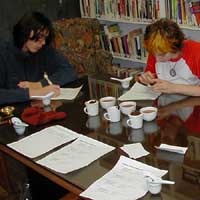 For the last four years, I’ve been teaching a tea class at a unique and cutting-edge school called the Puget Sound Community School. The class meets once per week and I cover some aspect of tea–sensory testing, culture, history, processing, geography, chemistry, biology, or (as we did a couple of weeks ago) just sitting around in the library drinking tea and watching Wallace and Gromit with crackers and Wensleydale.
For the last four years, I’ve been teaching a tea class at a unique and cutting-edge school called the Puget Sound Community School. The class meets once per week and I cover some aspect of tea–sensory testing, culture, history, processing, geography, chemistry, biology, or (as we did a couple of weeks ago) just sitting around in the library drinking tea and watching Wallace and Gromit with crackers and Wensleydale.
Students have come and gone over the years, but they’ve developed quite a bit of tea skill and knowledge, if I do say so myself. When I challenged them with a blind taste test of several wulongs and had them guess (by taste only) the general level of oxidation and general level of roast of each tea, the basic consensus amongst the students was pretty accurate.
I brought in three Keemun teas (a congou, a mao feng, and a hao ya) and brewed them according to the ISO sensory test for black tea guidelines–without milk–their average scores for each tea clearly ranked them in order of quality. This tasting is what’s shown in the photo.
And I’ve already written about the comparison I did in my Dragonwell tasting post and the followup I did at PSCS in my Dragonwell at PSCS post. If you’ve been following along, you’ll recall they nailed that one as well. Who knew junior high and high school students would be able to so accurately determine price and quality of tea just by taste?
They do me proud.







